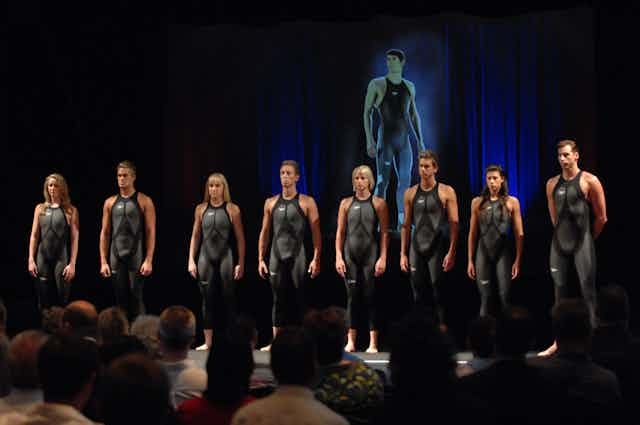To win Olympic gold is a lifelong dream for most swimmers. It is the culmination of years of training and dedication. In Australia, to win Olympic gold is to become a celebrity, a superstar, an Australian hero. The sponsorships that accompany the glory of gold can provide financial stability.
So Olympic competitors use every advantage available to them, including the best coaches, the latest training techniques, the most efficient swim styles, the greatest fitness level, and the best equipment available. For swimmers, this includes “fast suits”. Or it least it did until fast suits were banned in the lead up to the London Olympics.
More on fast suits in a moment, but first it’s important to understand the forces acting upon a swimmer.
What a drag - beating water’s pull
In the water, invisible forces slow the swimmer down. These fluid forces - called drag - push against your swimming motion. To a degree, swimmers can control the amount of drag they experience by:
Controlling how they present to the water, starting with the dive. When swimmers jump off a block, they glide underwater reducing surface drag. Once they surface, swimmers push up a smaller wave in front of them, slowing them down.
Shaving body hair. This cuts drag by smoothing the body surface. With less roughness, the water will flow across the body more easily.
Strengthening muscles. Strong abdominal muscles will help swimmers stay straighter and float higher in the water. With a strong upper body, there is less drag because of compensation with powerful strokes.

But there are steps that can be taken to reduce drag, beyond those mentioned above.
Speedo, the swimwear manufacturer, has a research and development facility where they work with experts from diverse industries including aerospace, engineering, medicine, sport science, textile technology and garment construction to improve swimming performance even further
Their fast suits are designed using data from body scans of hundreds of elite international swimmers. To virtually analyse the drag and flow of water around swimmers, they create virtual swimmers inside a computer.
The overall fit of the suit is engineered from the same body scan data, resulting in an “optimum biomechanical fit”.
Giving swimmers a second skin
The latest technologies surrounding racing swimsuits are aimed at:
- reducing drag in the water
- creating fabrics that cling to the body and repel water
- creating fabrics that compress muscles and mould the shape of the body
- bonding fabric seams together while allowing stretch
- replicating a shark’s dermal denticles - its skin scales - to reduce drag and increase speed.

The technology is a fabric that is extremely lightweight. It is a high-density microfibre fabric woven from chlorine-resistant elastane and ultra-fine nylon yarn. The fabric allows for various water-flow patterns over the whole body, producing a smoother swim and reducing drag by up to 4%.
The fabric is made from nylon which is a hydrophobic (water-hating) molecule. This means that very little water enters the fibre. These fibres are then manufactured into fabric and a finishing or bonding process is applied that produces durable and long lasting water-repellent finish.
The “super stretch” fabric improves the suit’s fit while compressing muscles. It has very low skin friction, and the result is a reduction of drag and muscle vibration, which increases productivity.
As an additional feature, gripper fabric is now included along the forearm area. This friction is required for the swimmer to pull themselves through the water using strong arm movements.
Bonded and welded seams that follow the direction of the water flow and reduce drag allow comfort and freedom of movement by using super stretch thread. Here, the seams act like tendons and provide tension in the suit. The fabric panels act like muscles, stretching and returning to their original shape.
Hi-tech, but low acceptance
Because it’s very fast in the water, the shark was used as a model for the swimsuits. The shark’s quickness is attributed to V-shaped ridges on its skin called “dermal denticles” which decrease drag and turbulence around its body. This feature has been emulated in the swimsuit.
So what’s the current legal status of the fast suit?
Well, in terms of the 2012 Olympics, the international governing body for swimming, the Federation Internationale de Nation (FINA), have legalised, banned, legalised and again banned the use of full-body fast suits.
Half-body textile suits are allowed, and competitors can select from a range of different suits.
And while fast suits have been banned for these games, FINA has declared that previous Olympic and world records set by swimmers wearing fast suits – all 40 of them – will still stand.
So if fast suits do provide the competitive advantage that FINA and all associated research has attributed to them, the return to half-body textile suits could explain why we’ve seen fewer world and Olympic swimming records broken in London than we did in Beijing.

